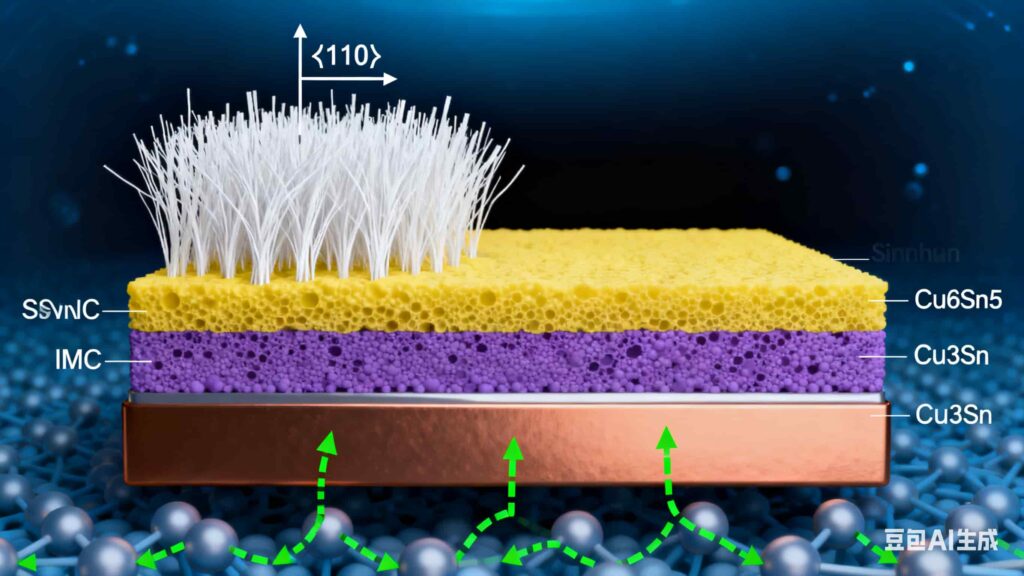Tin Whiskers in Electronics: Causes, Growth Mechanism, and Prevention Solutions
What Are Tin Whiskers?
Tin whiskers are hair-like crystalline structures that spontaneously grow from the surface of tin. To understand tin whiskers, we must first explain “metal whiskers.” A whisker is a filament-shaped crystal that naturally grows from the surface of solid metals. They can appear on many metals, most commonly tin, cadmium, zinc, antimony, and indium.

In some cases, whiskers may also form on tin-lead alloys, although the probability is lower. Metals such as lead, iron, silver, gold, and nickel rarely exhibit whisker growth. In general, whiskers tend to occur on soft, ductile, and low-melting-point metals.
Tin whiskers are electrically conductive, single-crystal structures that can grow in straight, twisted, grooved, or cross-linked shapes, and sometimes appear hollow. Their diameters can reach up to 10 microns, with lengths exceeding 9 mm in extreme cases. They are capable of carrying currents of around 10 mA, although larger currents usually burn them away.
While most tin whiskers are only a few millimeters long, they can cause serious problems in electronic assemblies:
- Electrical short circuits, when whiskers bridge conductive paths.
- Mechanical damage, as whiskers grow and release stress from the underlying tin layer.
Because the mechanisms behind whisker growth are still not fully understood and reliable testing methods are lacking, tin whiskers pose significant risks in high-reliability systems such as satellites, aerospace, and defense electronics. Despite this, the demand for lead-free and environmentally friendly components continues to drive the use of pure tin plating, which increases whisker risks.
Causes of Tin Whisker Growth
Tin whisker growth rates are typically 0.03–0.9 mm/year, but under certain conditions, they may accelerate by a factor of 100 or more. Growth depends on complex factors including:
- Electroplating chemistry
- Plating thickness
- Substrate material
- Grain structure
- Storage environment
The major causes of tin whiskers include:
- Tin–Copper Intermetallic Formation
Diffusion between tin and copper creates intermetallic compounds, building internal stress in the tin layer. This stress drives tin atoms to migrate along grain boundaries, forming whiskers. - Residual Stress from Electroplating
Stress introduced during plating processes is another key driver for whisker formation.
Solutions to Prevent Tin Whiskers
Several engineering solutions have been developed to reduce or suppress tin whisker growth:
- Matte Tin Plating – Modifies the crystal structure and reduces internal stress.
- Annealing – Baking at 150 °C for 2 hours relieves residual stress. Studies show tin whisker growth stops above 90 °C.
- Additives in Plating – For example, the Enthone FST immersion tin process introduces organometallic additives to suppress tin-copper intermetallic formation.
- Barrier Layers – Adding a nickel layer between copper and tin prevents diffusion.
- Lead Alloying – Adding a small amount of lead to tin effectively suppresses whisker growth. However, this approach is restricted due to environmental regulations (RoHS).
- Gold Alloying – Adding 1–2% gold has also been shown to inhibit tin whisker formation.
Conclusion
Tin whiskers remain a critical reliability challenge in electronics manufacturing. While the industry has developed several mitigation techniques, no single method provides a complete solution. As demand for lead-free, RoHS-compliant electronics grows, research into new whisker suppression methods—such as advanced plating chemistries and alloying strategies—remains essential for ensuring the long-term stability of electronic systems.
